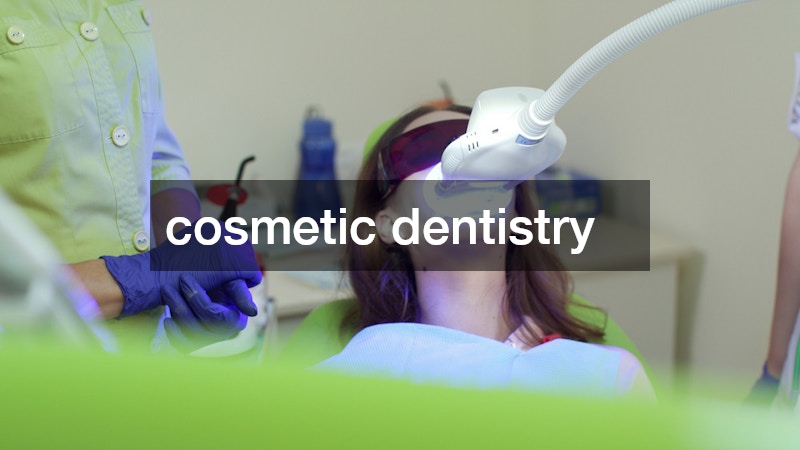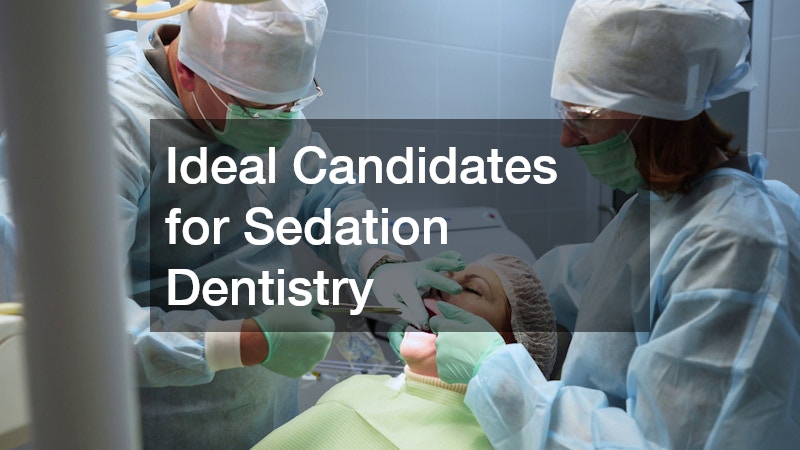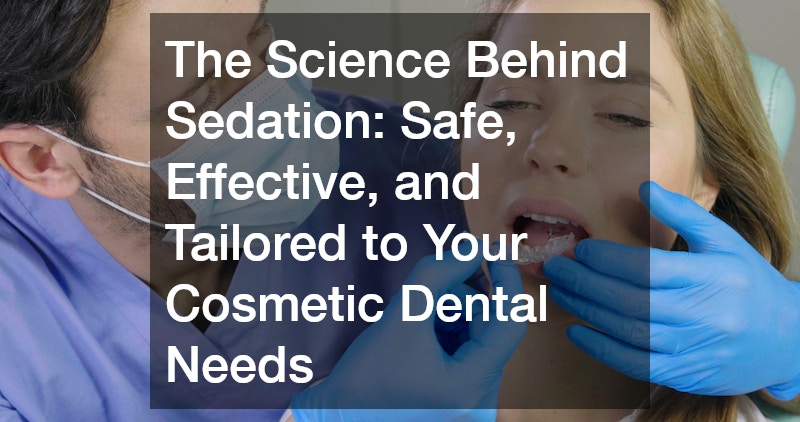
- An experienced cosmetic dentist offering sedation ensures both safety and aesthetic precision.
- Different sedation types (nitrous oxide, oral, IV) suit different comfort and treatment needs.
- Sedation allows multiple procedures to be completed in fewer, longer sessions.
- It’s safe when properly administered and tailored to your health profile.
- Ideal for patients with dental anxiety, strong gag reflex, or complex smile goals.
- Pre-screening and post-care are essential for a smooth and successful experience.
- Sedation dentistry makes cosmetic procedures more comfortable and anxiety-free.

A beautiful smile has the power to transform not just appearances, but confidence, self-esteem, and even the way you interact with the world. However, many people hesitate to pursue cosmetic dental procedures due to fear, anxiety, or past traumatic experiences at the dentist. If this sounds like you, you’re not alone. Fortunately, advancements in modern dentistry—specifically sedation techniques—have made it possible for patients to enjoy cosmetic treatments in a calm, stress-free environment.
Whether you’re planning to get veneers, teeth whitening, or a complete smile makeover, working with an experienced cosmetic dentist who offers sedation can make all the difference in your comfort and results. This article explores the science behind dental sedation, the types available, how it enhances cosmetic procedures, and what to expect before, during, and after your treatment.
What Is Sedation Dentistry?
Sedation dentistry uses medication to make patients feel calm and at ease during dental procedures. It’s particularly useful for those who experience dental phobia, need extensive or lengthy treatments, or have difficulty sitting still for long periods.
Unlike general anesthesia—which renders patients completely unconscious and is rarely used in routine dental care—most forms of dental sedation simply induce a relaxed, semi-awake state. Many patients feel sleepy and may remember little or nothing about the treatment afterward. This makes it an ideal option for cosmetic or restorative procedures that can take several hours to complete.
Why Choose an Experienced Cosmetic Dentist Who Offers Sedation?
Choosing a qualified cosmetic dentist who provides sedation isn’t just about comfort—it’s also about ensuring optimal results. These professionals understand how to safely pair cosmetic procedures with sedation methods, allowing for longer, more efficient appointments with higher patient satisfaction.
Here’s why this combination is ideal:
- Comprehensive smile makeovers become more manageable in fewer appointments.
- Anxiety or fear no longer stands in the way of achieving the smile you want.
- Advanced sedation techniques are tailored to your comfort level and health history.
- Highly skilled cosmetic dentists understand facial symmetry and aesthetics, ensuring your sedation-supported procedure is both safe and effective.
Types of Sedation Used in Cosmetic Dentistry
An experienced cosmetic dentist who offers sedation will typically use one or more of the following methods, depending on your needs, preferences, and the complexity of your procedure:
1. Nitrous Oxide (Laughing Gas)
Nitrous oxide provides light sedation and is administered through a small nasal mask. Patients typically feel its calming effects within minutes, and because it exits the system rapidly, normal activities can often resume shortly after the procedure ends.
Best suited for:
- Mild dental anxiety
- Short procedures, like in-office teeth whitening
- Patients who need to return to work or drive afterward
Benefits:
- Fast-acting and easy to administer
- No recovery time needed
- Safe for both adults and children
- Adjustable during the procedure for optimal comfort
2. Oral Conscious Sedation
This involves taking a prescribed sedative pill (often diazepam or triazolam) about an hour before the procedure. It offers deeper relaxation compared to nitrous oxide and is ideal for moderate anxiety or more involved cosmetic treatments.
Best suited for:
- Patients with moderate anxiety
- Procedures lasting more than an hour (e.g., veneers or bonding multiple teeth)
- Those who want to feel relaxed but stay conscious
Benefits:
- Easy administration (just a pill)
- Amnesic effects—most patients don’t remember the procedure
- Can be combined with nitrous oxide for an enhanced effect
- Moderate sedation without the need for IV
3. IV Sedation
Delivered through a vein, IV sedation offers a more profound calming effect, making it well-suited for lengthy or more involved dental treatments. While you remain awake, you’ll feel deeply relaxed—almost as if you’re asleep—and are unlikely to recall much, if any, of the procedure afterward.
Best suited for:
- Full smile makeovers
- Dental implant surgeries
- Patients with severe anxiety or a gag reflex
Benefits:
- Immediate effect
- Sedation level can be adjusted in real time
- Allows the dentist to complete extensive work in fewer visits
- Deeper relaxation than oral sedation
Tailoring Sedation to Cosmetic Dental Needs
Not all dental procedures are the same, and neither are all patients. A skilled cosmetic dentist offering sedation takes a personalized approach, considering factors like:
- Medical history and current medications
- The complexity and duration of the cosmetic procedure
- Patient anxiety levels or past dental trauma
- Pain sensitivity and gag reflex
- Time constraints or preference for fewer appointments
This customization means sedation is not a one-size-fits-all solution. Instead, it’s an integral part of treatment planning that enhances both the patient experience and final results.
Cosmetic Dental Procedures Enhanced by Sedation
Sedation isn’t just for oral surgery or extractions—it’s incredibly useful for a wide range of cosmetic dental treatments, including:
1. Veneers and Lumineers
Placing veneers requires reshaping the enamel, taking impressions, and ensuring a perfect fit and aesthetics. Sedation helps ease the long, detail-oriented process.
2. Teeth Whitening (In-Office)
Patients with sensitive teeth or dental anxiety can benefit from mild sedation to stay comfortable during the procedure.
3. Dental Bonding and Contouring
These require precision and a steady patient. Sedation keeps you relaxed, so your dentist can focus on the artistry.
4. Dental Implants
Implant surgery can be intimidating, but with IV sedation, it becomes a peaceful, pain-free experience.
5. Smile Makeovers
Comprehensive cosmetic treatment plans often involve several procedures at once. Sedation makes it possible to combine them in fewer sessions, saving time and ensuring a better overall experience.
Is Sedation Dentistry Safe?
Absolutely—when performed by an experienced cosmetic dentist trained and licensed in sedation techniques, the process is both safe and well-regulated. Dentists must complete specific coursework and hands-on training, and they adhere to rigorous guidelines to monitor patients throughout treatment.
Safety Measures Include:
- Pre-procedure medical screening
- Continuous monitoring of vital signs (heart rate, oxygen levels, blood pressure)
- Emergency equipment and protocols on hand
- Clear post-operative instructions to ensure recovery
- Escort requirements for certain levels of sedation (especially oral and IV)
Tip: Always disclose your full medical history, medications, and supplements during your consultation so your dentist can choose the safest sedation option.
Benefits of Sedation in Cosmetic Dentistry
Sedation provides both physical and emotional benefits that make cosmetic procedures more accessible and enjoyable:
Physical Benefits:
- Minimizes pain and discomfort
- Reduces jaw fatigue during lengthy procedures
- Controls the gag reflex
- Allows for multiple procedures in one session
Emotional Benefits:
- Reduces anxiety and fear
- Encourages patients to complete treatment plans
- Builds trust and comfort with dental visits
- Offers a sense of control and relaxation
Ideal Candidates for Sedation Dentistry

You might be an ideal candidate for sedation if you:
- Have moderate to severe dental anxiety or phobia
- Are undergoing a complex or time-consuming cosmetic procedure
- Have a sensitive gag reflex
- Experience difficulty getting numb with local anesthetic alone
- Have had traumatic dental experiences in the past
- Prefer fewer, longer appointments instead of multiple short ones
Patients who may need extra consideration include:
- Those with respiratory or cardiovascular conditions
- Pregnant or breastfeeding women
- Individuals with certain allergies or drug interactions
- Seniors with complex health issues
In such cases, your cosmetic dentist will work with your physician or refer you to a specialist for a tailored approach.
What to Expect Before, During, and After Sedation
Before Your Appointment:
- You’ll have a consultation to review your health, medications, and dental goals
- Pre-operative instructions may include fasting or avoiding certain medications
- Arrange for a friend or family member to drive you home if using oral or IV sedation
During the Appointment:
- You’ll receive your sedation method as planned (gas, pill, or IV)
- The dental team will monitor your vitals throughout the procedure
- You’ll remain relaxed and comfortable, often with little memory of the work done
After the Appointment:
- Recovery time depends on the type of sedation used
- Most patients feel drowsy and are advised to rest for the remainder of the day
- Detailed aftercare instructions will be provided, especially if work was done on teeth or gums
- Follow-up visits may be scheduled to assess healing or continue your smile transformation
Frequently Asked Questions
- Is sedation covered by dental insurance?
Generally, sedation is considered elective and not covered by insurance, especially for cosmetic procedures. However, some plans may cover sedation if it’s deemed medically necessary. Check with your provider for specifics. - Will I be asleep during the procedure?
With most forms of dental sedation (except general anesthesia), you remain conscious but deeply relaxed. Many patients don’t remember the procedure afterward. - Can I choose the level of sedation?
Yes, an experienced cosmetic dentist who offers sedation will walk you through your options and help you choose based on your comfort level, procedure complexity, and medical background. - Is sedation dentistry safe for children?
Yes, when administered properly. However, it’s typically reserved for cases where a child cannot tolerate necessary treatment otherwise. Parents should consult a pediatric dental specialist.
Final Thoughts
Cosmetic dentistry is no longer just about appearance—it’s about how you feel throughout the entire experience. Working with an experienced cosmetic dentist who offers sedation opens the door to a new level of comfort, safety, and efficiency in dental care. Whether you’re dreaming of a whiter smile, straighter teeth, or a full transformation, sedation makes it easier than ever to take that first step.

